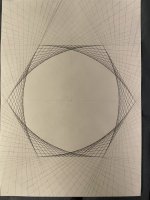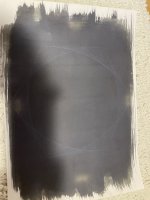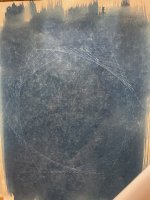and the site receives a small commission
You are using an out of date browser. It may not display this or other websites correctly.
You should upgrade or use an alternative browser.
You should upgrade or use an alternative browser.
Cyanotype video.
- Thread starter Peter B
- Start date
- Messages
- 16,290
- Name
- Andy Grant
- Edit My Images
- Yes
- Messages
- 16,290
- Name
- Andy Grant
- Edit My Images
- Yes
Nope, just a an old picture frame. I sandwiched the coated paper between the glass and the backboard with some small bulldog clips and left them out in the sun for an amount of time, worked perfectly. I bought the paper ready coated but if I do it again I'll get the chemistry and coat my own.
- Messages
- 1,142
- Name
- Mike
- Edit My Images
- Yes
I've been meaning to try doing my own, and bulldog clips sounds a much better solution than the frame. I was a little surprised Photography on-line didn't name the chemicals needed, and even had their versions labelled in French. I've got 100g of one of the reagents (ammonium ferrrocyanate IIRC) & will eventually get round to ordering the other. I'll dissolve them up myself.Nope, just a an old picture frame. I sandwiched the coated paper between the glass and the backboard with some small bulldog clips and left them out in the sun for an amount of time, worked perfectly. I bought the paper ready coated but if I do it again I'll get the chemistry and coat my own.
The sun prints I've done previously where certainly a lot quicker than their UV box, but they where done in the summer & somewhat further south than Skye.
There no need to restrict yourself to paper it works well on fabrics too, i think Cyanotypes could make some cool Tee shirts...
The background in the shot below is a cyanotype on fabric done by my wife (feel free to ignore the camera porn):
 ultra macro lens set up by Mike Kanssen, on Flickr
ultra macro lens set up by Mike Kanssen, on FlickrI'd not heard the tip about using hydrogen peroxide for darkening the colour before, must remember that...
Last edited:
- Messages
- 1,231
- Name
- Mike
- Edit My Images
- Yes
A bit of thread-necromancy, but I recently dabbled a bit. For those still interested in cyanotype, check out Mike Ware's Cyanomicon book on it: https://www.mikeware.co.uk/mikeware/downloads.html
And here's an interesting read about the conversion of an enlarger to use for cyanotype: https://ssz.fr/cyano/
Spoiler: difficult to do, as lens glass absorbs UVA. Though some of the older enlarger lenses aren't so bad.
I'm pondering whether I should give the enlarger conversion a try. Though I'm not sure where to best buy UV LEDs (Aliexpress?). Most of the run-of-the-mill E27 blacklight CFLs from Amazon are probably just normal bulbs dipped in black goop to block the visible range.
I also read in Mike Ware's book that it might be possible to only use the ammonium iron citrate/oxalate solution to sensitise the paper, expose and then develop it with the ferricyanide solution. Ferricyanide strongly absorbs in the low 400nms, hence it quenches a lot of light.
Another idea floating through my brain: blue/UV lasers! https://hackaday.com/2019/12/18/use-blueprint-process-to-print-on-fabric-with-lasers/
No idea how to control galvanometers to create a rasterised image though. Could be fun?
And here's an interesting read about the conversion of an enlarger to use for cyanotype: https://ssz.fr/cyano/
Spoiler: difficult to do, as lens glass absorbs UVA. Though some of the older enlarger lenses aren't so bad.
I'm pondering whether I should give the enlarger conversion a try. Though I'm not sure where to best buy UV LEDs (Aliexpress?). Most of the run-of-the-mill E27 blacklight CFLs from Amazon are probably just normal bulbs dipped in black goop to block the visible range.
I also read in Mike Ware's book that it might be possible to only use the ammonium iron citrate/oxalate solution to sensitise the paper, expose and then develop it with the ferricyanide solution. Ferricyanide strongly absorbs in the low 400nms, hence it quenches a lot of light.
King’s policy of ‘separate development’ can, however, justly claim one
advantage: an increase in printing speed. In a conventional mixed
cyanotype sensitizer the ferricyanide ion inevitably absorbs some of the
actinic blue and UVA light non-productively, owing to its strong
absorption band peaking at 420 nm, which thereby lowers the sensitivity
Another idea floating through my brain: blue/UV lasers! https://hackaday.com/2019/12/18/use-blueprint-process-to-print-on-fabric-with-lasers/
No idea how to control galvanometers to create a rasterised image though. Could be fun?
- Messages
- 1,231
- Name
- Mike
- Edit My Images
- Yes
Yes, something like this might be the way to go. I'm not sure that 7-14W output will cut it though.perhaps look at something more like the UV resin print hardening lamps that are based on LED Cree emitters...
say something like this ?
I've browsed around a fair amount, looking for a larger chip with an integrated driver, but couldn't find anything (affordable) in UVA. Stumbled across 100W chips, but they needed 30-34V DC and drivers for this order of magnitude are pricy (given that I don't know whether this will work
TheBigYin
Moderator
- Messages
- 16,667
- Name
- Mark
- Edit My Images
- No
how about UV Floodlights ? built in driver and a crapton of led emitters in one case
- Messages
- 1,231
- Name
- Mike
- Edit My Images
- Yes
Not gone any further with UV lamps yet, but I can report that normal printer paper works for contact printing.
Template:

After about 3 hours on a sunny day (need to test more).

After developing. Not fully oxidised yet.

The template needed stronger lines to better show. But I’m quite happy that the fine black lines showed up at all.
I’ll have to do some test strips over the summer to see what the true exposure time for printer paper contact printing should be.
Edit: thinking about this some more; it will be interesting to see how actual photo contrast translates with this.
Template:

After about 3 hours on a sunny day (need to test more).

After developing. Not fully oxidised yet.

The template needed stronger lines to better show. But I’m quite happy that the fine black lines showed up at all.
I’ll have to do some test strips over the summer to see what the true exposure time for printer paper contact printing should be.
Edit: thinking about this some more; it will be interesting to see how actual photo contrast translates with this.
Last edited:

